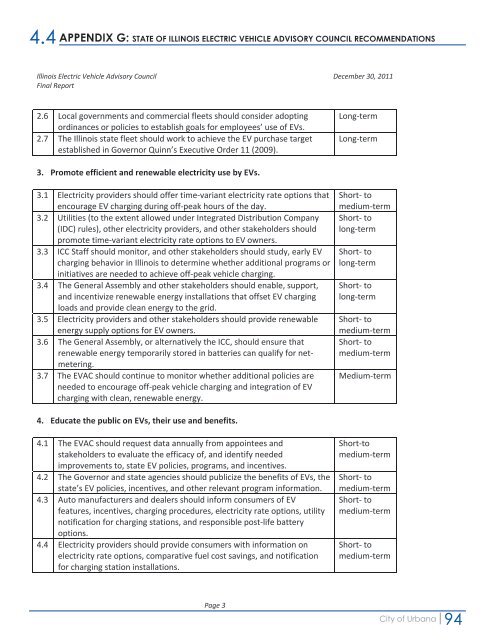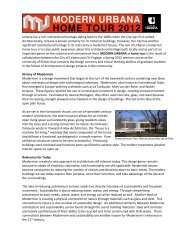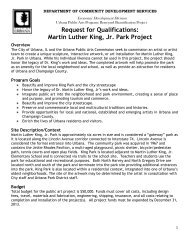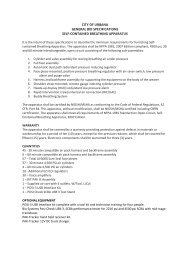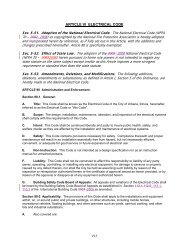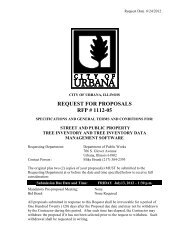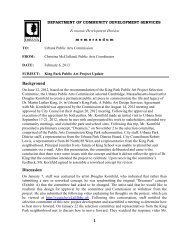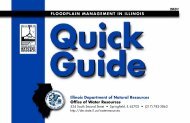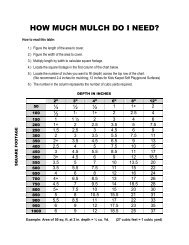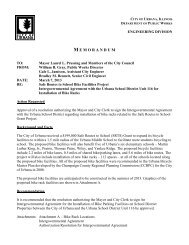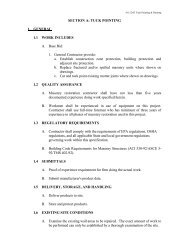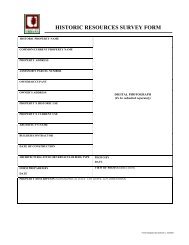CLIMATE ACTION PLAN - City of Urbana
CLIMATE ACTION PLAN - City of Urbana
CLIMATE ACTION PLAN - City of Urbana
- No tags were found...
You also want an ePaper? Increase the reach of your titles
YUMPU automatically turns print PDFs into web optimized ePapers that Google loves.
4.4 APPENDIX G: STATE OF ILLINOIS ELECTRIC VEHICLE ADVISORY COUNCIL RECOMMENDATIONS<br />
Illinois Electric Vehicle Advisory Council December 30, 2011<br />
Final Report<br />
2.6 Local governments and commercial fleets should consider adopting<br />
ordinances or policies to establish goals for employees’ use <strong>of</strong> EVs.<br />
2.7 The Illinois state fleet should work to achieve the EV purchase target<br />
established in Governor Quinn’s Executive Order 11 (2009).<br />
Long‐term<br />
Long‐term<br />
3. Promote efficient and renewable electricity use by EVs.<br />
3.1 Electricity providers should <strong>of</strong>fer time‐variant electricity rate options that<br />
encourage EV charging during <strong>of</strong>f‐peak hours <strong>of</strong> the day.<br />
3.2 Utilities (to the extent allowed under Integrated Distribution Company<br />
(IDC) rules), other electricity providers, and other stakeholders should<br />
promote time‐variant electricity rate options to EV owners.<br />
3.3 ICC Staff should monitor, and other stakeholders should study, early EV<br />
charging behavior in Illinois to determine whether additional programs or<br />
initiatives are needed to achieve <strong>of</strong>f‐peak vehicle charging.<br />
3.4 The General Assembly and other stakeholders should enable, support,<br />
and incentivize renewable energy installations that <strong>of</strong>fset EV charging<br />
loads and provide clean energy to the grid.<br />
3.5 Electricity providers and other stakeholders should provide renewable<br />
energy supply options for EV owners.<br />
3.6 The General Assembly, or alternatively the ICC, should ensure that<br />
renewable energy temporarily stored in batteries can qualify for netmetering.<br />
3.7 The EVAC should continue to monitor whether additional policies are<br />
needed to encourage <strong>of</strong>f‐peak vehicle charging and integration <strong>of</strong> EV<br />
charging with clean, renewable energy.<br />
Short‐ to<br />
medium‐term<br />
Short‐ to<br />
long‐term<br />
Short‐ to<br />
long‐term<br />
Short‐ to<br />
long‐term<br />
Short‐ to<br />
medium‐term<br />
Short‐ to<br />
medium‐term<br />
Medium‐term<br />
4. Educate the public on EVs, their use and benefits.<br />
4.1 The EVAC should request data annually from appointees and<br />
stakeholders to evaluate the efficacy <strong>of</strong>, and identify needed<br />
improvements to, state EV policies, programs, and incentives.<br />
4.2 The Governor and state agencies should publicize the benefits <strong>of</strong> EVs, the<br />
state’s EV policies, incentives, and other relevant program information.<br />
4.3 Auto manufacturers and dealers should inform consumers <strong>of</strong> EV<br />
features, incentives, charging procedures, electricity rate options, utility<br />
notification for charging stations, and responsible post‐life battery<br />
options.<br />
4.4 Electricity providers should provide consumers with information on<br />
electricity rate options, comparative fuel cost savings, and notification<br />
for charging station installations.<br />
Short‐to<br />
medium‐term<br />
Short‐ to<br />
medium‐term<br />
Short‐ to<br />
medium‐term<br />
Short‐ to<br />
medium‐term<br />
Page 3<br />
<strong>City</strong> <strong>of</strong> <strong>Urbana</strong><br />
94


